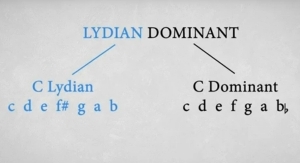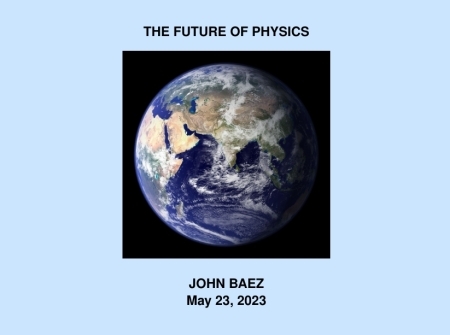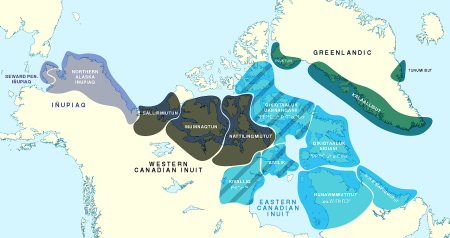John C. Baez's Blog, page 18
May 31, 2023
The Future of Physics
The 20th century was the century of fundamental physics. While we saw immense progress toward discovering the basic laws governing matter, space, and time, this has slowed to a crawl since 1980, despite an immense amount of work. Luckily, there’s plenty of exciting progress in other branches of physics: for example, using the fundamental physics we already know to design surprising new forms of matter! Like all other sciences in the 21st century, physics must also embrace the challenges of the...
May 29, 2023
Galois’ Fatal Duel
On this day in 1832, Evariste Galois died in a duel. The night before, he summarized his ideas in a letter to his friend Auguste Chevalier. Hermann Weyl later wrote “This letter, if judged by the novelty and profundity of ideas it contains, is perhaps the most substantial piece of writing in the whole literature of mankind.”
That seems exaggerated, but within mathematics it might be true. On top of that, the backstory is really dramatic! I’d never really looked into it, until today. Let me ...
May 9, 2023
Symmetric Spaces and the Tenfold Way
I’m giving a talk in Nicohl Furey’s series Algebra, Particles and Quantum Theory on Monday May 15, 2023 at 17:00 UTC, which is 10 am for me here in California:
Symmetric spaces and the tenfold way
Abstract: The tenfold way has many manifestations. It began as a tenfold classification of states of matter based on their behavior under time reversal and charge conjugation. Mathematically, it relies on the fact that there are ten super division algebras and ten kinds of Clifford algebras, where two ...
Cold-Resistant Trees

The Appalachians are an old, worn-down mountain chain that runs down the eastern side of North America. The ecology of the Appalachians is fascinating. For example:
Ecologists have tested many species of Appalachian trees to see how much cold they can survive. As you’d expect, for many trees the killing temperature is just a bit colder than the lowest temperatures at the northern end of their range. That makes sense: presumably they’ve spread as far north—and as far up the mountains—as th...
May 4, 2023
Categories for Epidemiology
Xiaoyan Li, Sophie Libkind, Nathaniel D. Osgood, Eric Redekopp and I have been creating software for modeling the spread of disease… with the help of category theory!
Lots of epidemiologists use “stock-flow diagrams” to describe ordinary differential equation (ODE) models of disease dynamics. We’ve created two tools to help them.
The first, called StockFlow.jl, is based on category theory and written in AlgebraicJulia, a framework for programming with categories that many people either at or as...
May 2, 2023
Compositional Epidemiology
To give a talk at Applied Category Theory 2023 you have to submit an unpublished paper or an abstract. Here’s a draft of an abstract that I plan to submit. Take it as a quick summary of many things I should be blogging about here!
If this talk is accepted it will be called “Software for Compositional Modeling in Epidemiology”. It’s about work by Xiaoyan Li, Sophie Libkind, Nathaniel D. Osgood, Eric Redekopp and me. The abstract is a bit dry but it efficiently says what we’ve been up to. T...
April 30, 2023
The Bebop Major Scale
Though people say ‘octave’, there are only 7 different notes in the major scale. This is annoying if you’re trying to play scales in melodies with, say, 8 beats per measure. The scale keeps drifting out of synch.
One solution is to add an extra note to your scale! In this video, jazz cat Adam Maness explains the virtues of the ‘bebop major scale’, where you add a minor 6th to the major scale:
1 2 3 4 5 ♭6 6 7
Just playing this scale up and down, 8 beats per measure, already suggests some me...
April 26, 2023
Bosons, Fermions and Clifford Algebras
A minus sign can make a huge difference. Einstein discovered that the difference between space and time is all due to a minus sign.
Another amazing fact is that the difference between ‘matter particles’ (or more precisely fermions, like electrons, quarks, etc.) and ‘force particles’ (bosons, like photons, gluons, etc.) is mainly due to the fact that when you switch two fermions their quantum state gets multiplied by -1, while when you switch two bosons it get multiplied by 1.
This was discovere...
April 21, 2023
The Lydian Dominant Scale
I got excited when I learned about the Lydian dominant scale:
1 2 3 #4 5 6 ♭7
and could sing it without much effort on the first try. I seem to be getting better at this sort of thing!
More importantly, it’s a really cool scale. Rob van Hal’s video explains what it sounds like and what you can do with it:
You can think of it as a blend of the Lydian mode, with its mystical raised 4th:
1 2 3 #4 5 6 7
and the Mixolydian, with its lowered 7th:
1 2 3 4 5 6 ♭7

But why does this image from van ...
April 17, 2023
Kaktovik Numerals
I’m fascinated by the Inuit languages in Alaska, Canada and Greenland. There are many of these languages: they ring much of the Arctic Ocean. I just learned that they use a base 20 system for numbers, with a ‘sub-base’ of 5. That is, quantities are counted in scores (twenties) with intermediate numerals for 5, 10, and 15. This makes a lot of sense if you look at your fingers and toes.
But the Inuit didn’t have a written form of their number system until the early 1990s, when high school ...
John C. Baez's Blog
- John C. Baez's profile
- 29 followers





